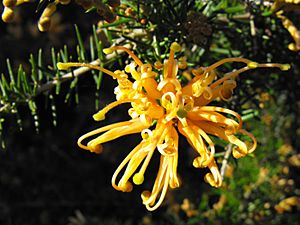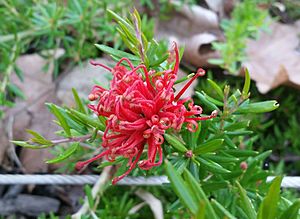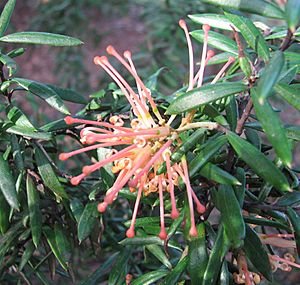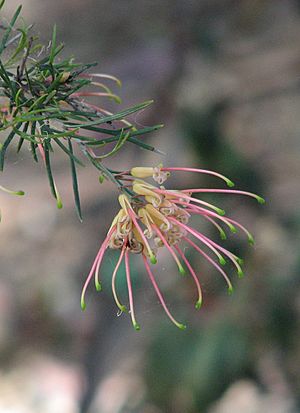Prickly spider-flower facts for kids
Quick facts for kids Prickly spider-flower |
|
|---|---|
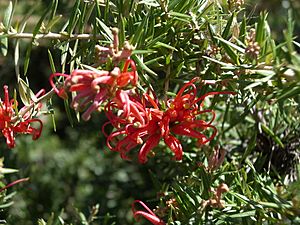 |
|
| Scientific classification | |
| Genus: |
Grevillea
|
| Species: |
juniperina
|
The Grevillea juniperina, also known as the prickly spider-flower, is a cool plant from the Proteaceae family. It grows naturally in eastern New South Wales and south-eastern Queensland in Australia. A Scottish botanist named Robert Brown first described this plant in 1810. Today, scientists recognize seven different types, called subspecies. One of these, G. j. juniperina, is only found in Western Sydney and nearby areas. It's in danger because its home is being lost to new houses and buildings.
This plant is a small, prickly shrub that can grow from about 20 centimeters (8 inches) to 3 meters (10 feet) tall. It usually grows in eucalypt woodlands, often in clay or alluvial soils. Its unique flower heads, called inflorescences, look like spiders and bloom from winter to early summer. They can be red, orange, or yellow. Birds love to visit these flowers and help them spread their pollen. If there's a bushfire, Grevillea juniperina plants die, but new ones grow from seeds left in the soil. This plant is also popular in gardens because it's easy to grow and has been used to create many beautiful hybrid garden plants.
Contents
What the Prickly Spider-Flower Looks Like
Grevillea juniperina can grow in different ways. It might spread out low to the ground or stand tall and upright. It usually reaches between 20 centimeters (8 inches) and 3 meters (10 feet) in height. Its branches are strong and thick.
Leaves and Flowers
The leaves are usually stiff and prickly. They are about 0.5 to 3.5 centimeters long and 0.5 to 6 millimeters wide. These leaves grow close together along the stems.
This plant can flower all year round. However, it blooms most between mid-winter and early summer. The exact time depends on the specific type (subspecies). For example, subspecies allojohnsonii flowers from September to February. Subspecies trinervis blooms from August to December. Other types like juniperina, amphitricha, sulphurea, villosa, and fortis flower in August and September.
The flowers are arranged like a spider, with several individual flowers coming out from a central head. This is why it's called a spider-flower! The flowers can be red, pink, orange, yellow, or greenish. They are mostly found at the ends of the stems. Each flower is about 2.5 to 3.5 centimeters long. The outside of the flower (called the perianth) is a bit furry. The part that holds the seeds (the pistil) is smooth and about 1.5 to 2.7 centimeters long.
Seeds and Similar Plants
After flowering, seed pods grow. Each pod is about 10 to 18 millimeters long. When ripe, it releases one or two seeds. The seeds are narrow and oval, about 7.5 to 12 millimeters long and 2.2 to 3.3 millimeters wide. They have tiny hairs all over them.
Some other plants look similar to Grevillea juniperina. The Wingello grevillea (Grevillea molyneuxii) has a clear line on the underside of its leaves. The red spider-flower (G. speciosa) has wider leaves and a longer pistil.
How Scientists Classify This Plant
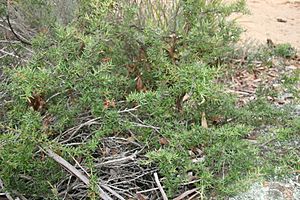
Scientists group and name plants based on their features. This is called Taxonomy. The first sample of Grevillea juniperina was collected near Port Jackson (Sydney). Botanist Robert Brown described it in 1810. He named it juniperina because its leaves look like those of a juniper plant. That's why it's also called juniper-leaf grevillea.
Over time, scientists have studied this plant more closely. They found different types, or subspecies, within Grevillea juniperina. In 2000, Bob Makinson from the New South Wales Herbarium officially recognized six of these subspecies.
Different Types of Prickly Spider-Flower
There are seven known subspecies of Grevillea juniperina:
- G. juniperina subsp. allojohnsonii: This type is a low-growing shrub, about 30 centimeters (12 inches) tall, with red flowers. It's found in northern New South Wales and southern Queensland.
- G. juniperina subsp. amphitricha: This shrub spreads out or grows low. It has yellow or orange flowers and can be 0.2 to 1.2 meters (8 inches to 4 feet) tall. It's found near Braidwood in New South Wales.
- G. juniperina subsp. fortis: This is a strong shrub with red flowers that grows 1 to 3 meters (3 to 10 feet) tall. It's found near rivers and creeks, mostly in the Australian Capital Territory.
- G. juniperina subsp. juniperina: This type only grows in Western Sydney, on clay soils. It's a spreading shrub, 0.5 to 1.5 meters (1.5 to 5 feet) high. This subspecies is considered vulnerable. This means it's at risk because its home is being lost to new houses, roads, and other human activities.
- G. juniperina subsp. sulphurea: This shrub can grow up to 2 meters (7 feet) tall. It likes alluvial soils and riverbanks in the Central and Southern Tablelands of New South Wales.
- G. juniperina subsp. trinervis: This is a prickly shrub that spreads out or grows low, from 0.5 to 1.2 meters (20 inches to 4 feet) tall. It has yellow, orange, or red flowers and is found in the western Blue Mountains.
- G. juniperina subsp. villosa: This is an upright shrub with red or yellow flowers, growing up to 2 meters (7 feet) tall. It's found along watercourses in eucalypt forests in southeastern New South Wales.
Where the Prickly Spider-Flower Lives
Grevillea juniperina can be found in different places. Unlike many other plants in its family, some types of Grevillea juniperina can grow well in clay soils. For example, G. juniperina subsp. juniperina lives in the Cumberland Plain and Castlereagh Woodland areas. It grows alongside trees like forest redgum (Eucalyptus tereticornis) and mugga ironbark (E. sideroxylon).
Other types, like G. juniperina subsp. sulphurea, prefer gravelly alluvial soil near Leptospermum plants. G. juniperina subsp. trinervis likes wet alluvial soil in woodlands or along riverbanks. It grows with trees like snow gum (Eucalyptus pauciflora) and mountain gum (E. dalrympleana). The areas where Grevillea juniperina grows usually get about 600 to 800 millimeters (24–32 inches) of rain each year.
Life Cycle and How it Survives
When a bushfire happens, Grevillea juniperina plants die. But they are very clever! New plants grow from seeds that have been waiting in the soil. These seeds need the heat and smoke from a fire to start growing. Plants that are taller than 1 meter (3 feet) produce more seeds. Scientists think that fires happening every 10 to 15 years are best for this plant. This gives enough time for new seeds to build up in the soil. Grevillea juniperina can also grow in areas that have been disturbed, like after a fire or land clearing.
Pollination and Food Chain
Birds are very important for Grevillea juniperina. They visit the flowers and help spread the pollen, which is how the plants reproduce. Bees have also been seen visiting the flowers. The leaves of this plant are a food source for the caterpillars of a butterfly called the cyprotus blue (Candalides cyprotus).
Growing Prickly Spider-Flower in Gardens
Grevillea juniperina is a great plant for gardens. It's easy to grow in many different types of soil and sunny spots, as long as the soil drains well. It flowers for a long time and its nectar attracts birds like honeyeaters. The prickly, dense leaves also make a good nesting spot and shelter for smaller birds.
Many different types and hybrids of Grevillea juniperina have been grown and sold for gardens. Colder winter temperatures can make the plant flower even more. Trimming the plant helps it grow thicker leaves. You can easily grow new plants from cuttings or seeds. However, using cuttings is the best way to make sure the new plant is exactly like the parent plant. Sometimes, touching the plant can cause a skin rash in some people.
Popular Garden Types
Many special types, called cultivars, have been created for gardens. Some are selected forms of G. juniperina, while others are hybrids with other Grevillea species. A famous breeder named Leo Hodge created many of these.
Here are a few popular types:
- Audrey: This is a hybrid that grows to 2 meters (7 feet) high and wide. It has orange-red flowers that bloom for many months. It's popular in South Africa and the USA.
- Canberra Gem: This is a hybrid of G. juniperina and G. rosmarinifolia.
- Molonglo: This type grows low and spreads out. It has larger orange flowers with red styles. It was created in 1964 and is named after the Molonglo River.
- New Blood: This is a compact shrub with red flowers.
- Poorinda Queen: This popular type has apricot-pink flowers. It was created by crossing G. juniperina with a yellow-flowered type of Grevillea victoriae.
- × semperflorens: This is a hybrid created in England.


